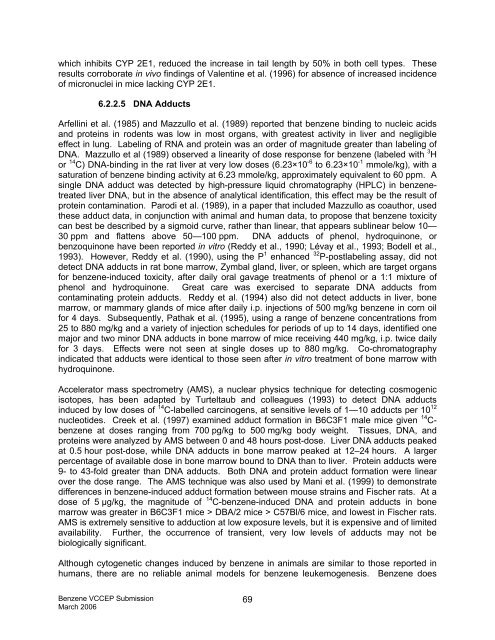(VCCEP) Tier 1 Pilot Submission for BENZENE - Tera
(VCCEP) Tier 1 Pilot Submission for BENZENE - Tera
(VCCEP) Tier 1 Pilot Submission for BENZENE - Tera
Create successful ePaper yourself
Turn your PDF publications into a flip-book with our unique Google optimized e-Paper software.
which inhibits CYP 2E1, reduced the increase in tail length by 50% in both cell types. These<br />
results corroborate in vivo findings of Valentine et al. (1996) <strong>for</strong> absence of increased incidence<br />
of micronuclei in mice lacking CYP 2E1.<br />
6.2.2.5 DNA Adducts<br />
Arfellini et al. (1985) and Mazzullo et al. (1989) reported that benzene binding to nucleic acids<br />
and proteins in rodents was low in most organs, with greatest activity in liver and negligible<br />
effect in lung. Labeling of RNA and protein was an order of magnitude greater than labeling of<br />
DNA. Mazzullo et al (1989) observed a linearity of dose response <strong>for</strong> benzene (labeled with 3 H<br />
or 14 C) DNA-binding in the rat liver at very low doses (6.23×10 -6 to 6.23×10 -1 mmole/kg), with a<br />
saturation of benzene binding activity at 6.23 mmole/kg, approximately equivalent to 60 ppm. A<br />
single DNA adduct was detected by high-pressure liquid chromatography (HPLC) in benzenetreated<br />
liver DNA, but in the absence of analytical identification, this effect may be the result of<br />
protein contamination. Parodi et al. (1989), in a paper that included Mazzullo as coauthor, used<br />
these adduct data, in conjunction with animal and human data, to propose that benzene toxicity<br />
can best be described by a sigmoid curve, rather than linear, that appears sublinear below 10—<br />
30 ppm and flattens above 50—100 ppm. DNA adducts of phenol, hydroquinone, or<br />
benzoquinone have been reported in vitro (Reddy et al., 1990; Lévay et al., 1993; Bodell et al.,<br />
1993). However, Reddy et al. (1990), using the P 1 enhanced 32 P-postlabeling assay, did not<br />
detect DNA adducts in rat bone marrow, Zymbal gland, liver, or spleen, which are target organs<br />
<strong>for</strong> benzene-induced toxicity, after daily oral gavage treatments of phenol or a 1:1 mixture of<br />
phenol and hydroquinone. Great care was exercised to separate DNA adducts from<br />
contaminating protein adducts. Reddy et al. (1994) also did not detect adducts in liver, bone<br />
marrow, or mammary glands of mice after daily i.p. injections of 500 mg/kg benzene in corn oil<br />
<strong>for</strong> 4 days. Subsequently, Pathak et al. (1995), using a range of benzene concentrations from<br />
25 to 880 mg/kg and a variety of injection schedules <strong>for</strong> periods of up to 14 days, identified one<br />
major and two minor DNA adducts in bone marrow of mice receiving 440 mg/kg, i.p. twice daily<br />
<strong>for</strong> 3 days. Effects were not seen at single doses up to 880 mg/kg. Co-chromatography<br />
indicated that adducts were identical to those seen after in vitro treatment of bone marrow with<br />
hydroquinone.<br />
Accelerator mass spectrometry (AMS), a nuclear physics technique <strong>for</strong> detecting cosmogenic<br />
isotopes, has been adapted by Turteltaub and colleagues (1993) to detect DNA adducts<br />
induced by low doses of 14 C-labelled carcinogens, at sensitive levels of 1—10 adducts per 10 12<br />
nucleotides. Creek et al. (1997) examined adduct <strong>for</strong>mation in B6C3F1 male mice given 14 Cbenzene<br />
at doses ranging from 700 pg/kg to 500 mg/kg body weight. Tissues, DNA, and<br />
proteins were analyzed by AMS between 0 and 48 hours post-dose. Liver DNA adducts peaked<br />
at 0.5 hour post-dose, while DNA adducts in bone marrow peaked at 12–24 hours. A larger<br />
percentage of available dose in bone marrow bound to DNA than to liver. Protein adducts were<br />
9- to 43-fold greater than DNA adducts. Both DNA and protein adduct <strong>for</strong>mation were linear<br />
over the dose range. The AMS technique was also used by Mani et al. (1999) to demonstrate<br />
differences in benzene-induced adduct <strong>for</strong>mation between mouse strains and Fischer rats. At a<br />
dose of 5 µg/kg, the magnitude of 14 C-benzene-induced DNA and protein adducts in bone<br />
marrow was greater in B6C3F1 mice > DBA/2 mice > C57Bl/6 mice, and lowest in Fischer rats.<br />
AMS is extremely sensitive to adduction at low exposure levels, but it is expensive and of limited<br />
availability. Further, the occurrence of transient, very low levels of adducts may not be<br />
biologically significant.<br />
Although cytogenetic changes induced by benzene in animals are similar to those reported in<br />
humans, there are no reliable animal models <strong>for</strong> benzene leukemogenesis. Benzene does<br />
Benzene <strong>VCCEP</strong> <strong>Submission</strong><br />
March 2006<br />
69





